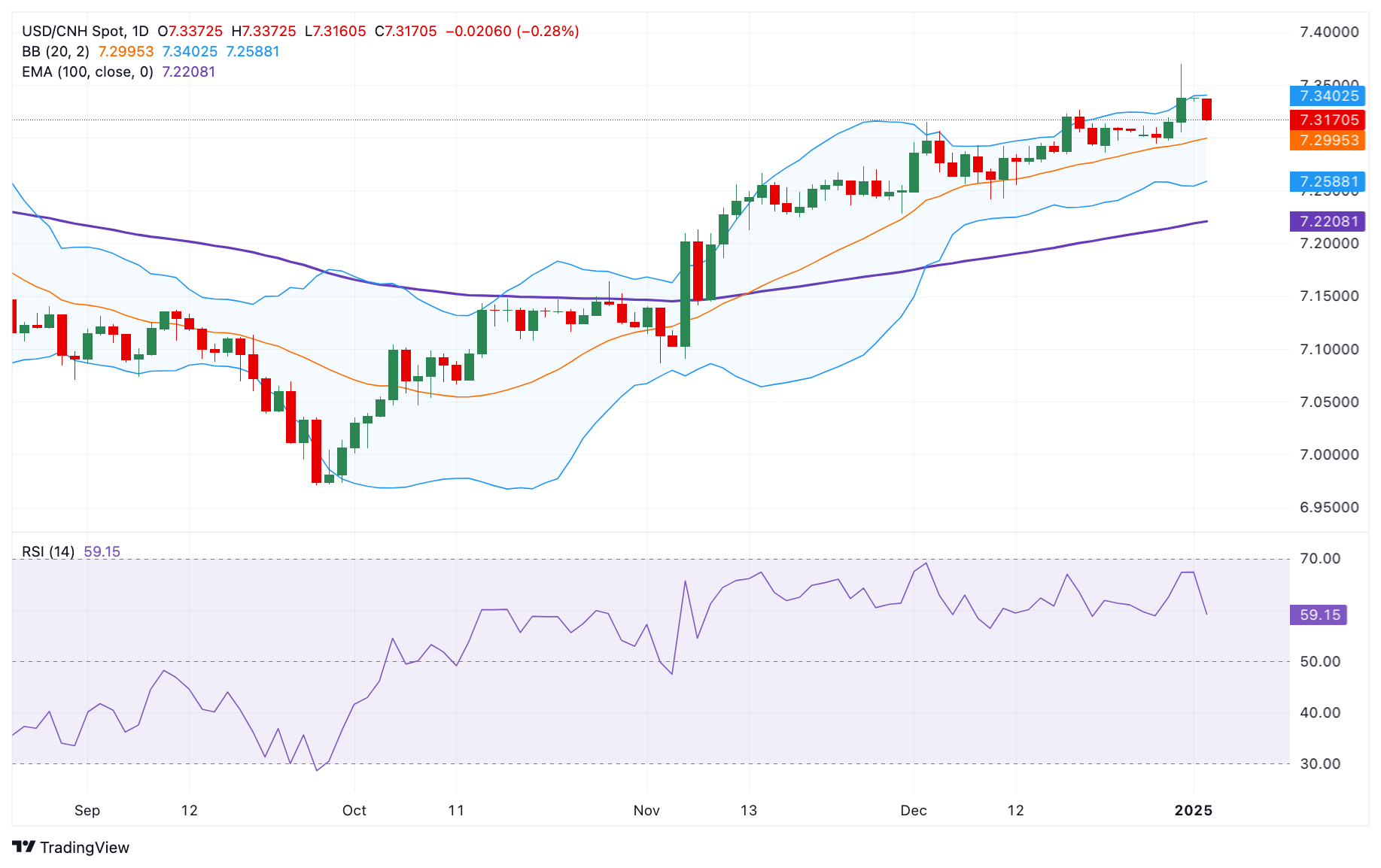- Analytics
- News and Tools
- Market News
- USD/CNH Price Forecast: The bullish tone remains in play above 7.3150
USD/CNH Price Forecast: The bullish tone remains in play above 7.3150
- USD/CNH weakens to around 7.3170 in Thursday’s early European session, down 0.29% on the day.
- The positive view of the pair prevails above the key 100-day EMA with the bullish RSI indicator.
- The first upside barrier is seen in the 7.3400-7.3405 zone; the initial support level is located at 7.2974.
The USD/CNH pair attracts some sellers to near 7.3170 during the early European trading hours on Thursday. However, the downside for the pair might be limited amid the prospect of slower US interest rate cuts in 2025 and the potential protectionist policies under incoming President Donald Trump.
The latest Chinese Caixin Manufacturing Purchasing Managers Index (PMI) showed that the country’s manufacturing sector came in weaker than expected in December. This reading raised concerns over a slowing economic recovery in the world's second-largest economy and might create a headwind for the Chinese Yuan.
According to the daily chart, the bullish outlook of USD/CNH remains intact, characterised by the price holding above the key 100-period Exponential Moving Average (EMA). The upward momentum is supported by the Relative Strength Index (RSI), which stands above the midline near 59.30, suggesting the path of least resistance is to the upside.
The confluence of the upper boundary of the Bollinger Band and the psychological level at the 7.3400-7.3405 region acts as an immediate resistance level for the pair. A decisive break above this level could pave the way to 7.3697, the high of December 31.
On the downside, the initial support level for USD/CNH emerges at 7.2974, the low of December 30. Extended losses could see a drop to 7.2745, the low of December 13. The additional downside filter to watch is 7.2588, the lower limit of the Bollinger Band.
USD/CNH daily chart
Fed FAQs
Monetary policy in the US is shaped by the Federal Reserve (Fed). The Fed has two mandates: to achieve price stability and foster full employment. Its primary tool to achieve these goals is by adjusting interest rates. When prices are rising too quickly and inflation is above the Fed’s 2% target, it raises interest rates, increasing borrowing costs throughout the economy. This results in a stronger US Dollar (USD) as it makes the US a more attractive place for international investors to park their money. When inflation falls below 2% or the Unemployment Rate is too high, the Fed may lower interest rates to encourage borrowing, which weighs on the Greenback.
The Federal Reserve (Fed) holds eight policy meetings a year, where the Federal Open Market Committee (FOMC) assesses economic conditions and makes monetary policy decisions. The FOMC is attended by twelve Fed officials – the seven members of the Board of Governors, the president of the Federal Reserve Bank of New York, and four of the remaining eleven regional Reserve Bank presidents, who serve one-year terms on a rotating basis.
In extreme situations, the Federal Reserve may resort to a policy named Quantitative Easing (QE). QE is the process by which the Fed substantially increases the flow of credit in a stuck financial system. It is a non-standard policy measure used during crises or when inflation is extremely low. It was the Fed’s weapon of choice during the Great Financial Crisis in 2008. It involves the Fed printing more Dollars and using them to buy high grade bonds from financial institutions. QE usually weakens the US Dollar.
Quantitative tightening (QT) is the reverse process of QE, whereby the Federal Reserve stops buying bonds from financial institutions and does not reinvest the principal from the bonds it holds maturing, to purchase new bonds. It is usually positive for the value of the US Dollar.
© 2000-2025. All rights reserved.
This site is managed by Teletrade D.J. LLC 2351 LLC 2022 (Euro House, Richmond Hill Road, Kingstown, VC0100, St. Vincent and the Grenadines).
The information on this website is for informational purposes only and does not constitute any investment advice.
The company does not serve or provide services to customers who are residents of the US, Canada, Iran, The Democratic People's Republic of Korea, Yemen and FATF blacklisted countries.
Making transactions on financial markets with marginal financial instruments opens up wide possibilities and allows investors who are willing to take risks to earn high profits, carrying a potentially high risk of losses at the same time. Therefore you should responsibly approach the issue of choosing the appropriate investment strategy, taking the available resources into account, before starting trading.
Use of the information: full or partial use of materials from this website must always be referenced to TeleTrade as the source of information. Use of the materials on the Internet must be accompanied by a hyperlink to teletrade.org. Automatic import of materials and information from this website is prohibited.
Please contact our PR department if you have any questions or need assistance at pr@teletrade.global.
















